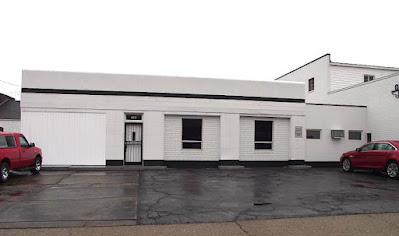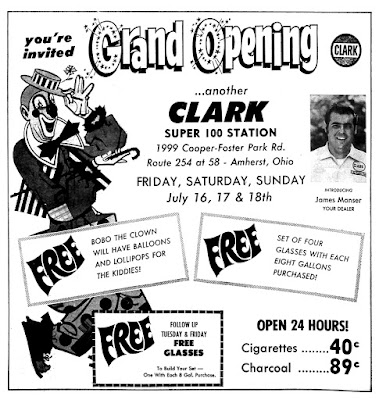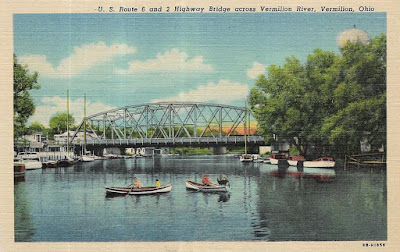Back in the early 1900s, the local newspapers seemed to contain a lot of articles of an archeological nature. Things (like old bones) were regularly being dug up or discovered, sometimes because farmland and woods that had been undisturbed for years were being developed.
But here’s the story of an ever older discovery, this time going back thousands of years. The article by John Love is from the July 27, 1928 Lorain Times-Herald and tells the story of some ancient footprints found at the quarries of the Cleveland Stone Company.
****
FOOT-PRINTS MADE 2,000 YEARS AGO FOUND AT AMHERST QUARRIES
By JOHN LOVE
When Nero fiddled while Rome went up in smoke and Helen of Troy was wrapped in secret trysts, and even years before that, Lorain county was not unknown to the world. It was not known as Lorain County or even suspected of being such a place. It probably had a name as long as the appendage of one of the ancient fabled dinosaurs.
That the section now covered by Amherst was inhabited in those long years ago is now a drawn conclusion with the finding recently of imprints of human feet in sandstone by employes of the Cleveland Stone Company which operates large quarries at Amherst.
Two or three thousand years ago a child about 12 years old, was tramping along what is known as the Rice farm in Amherst, and left an imprint in the sand. Centuries rolled by and events transpired quickly – the rise and fall of Rome, the fall of Troy, birth of Christ, Columbus voyage to American, but, even the ravages of time and the elements failed to efface the track made by the child. It has remained just as if it was left thousands of years ago.
It recently was removed from the farm by workmen of the quarry and is under lock and key at the stone company’s office.
With it is the imprint of a much larger foot – a flat foot for there is no sign of an arch. it is probably the pedal trace of an adult and is clearly and sharply defined.
The age of the relics was determined by geologists from all parts of Ohio who have viewed the unique specimens. They declared that at least 2,000 years is required for an imprint to solidify. So many geologists and naturalists visited the offices of the Cleveland Stone company to inspect the relics that no record has been kept of names, according to officials.
The experts also have pointed out the this discovery lends affirmation to the theory that this entire section once was covered by Lake Erie. The child and its adult parent were walking the beach leaving an imprint where the waves could not obliterate it.
The findings acts as a connecting link with ancestry too remote to be even generally considered by those whose years of scientific study have prepared them for just such research in the sublimities of time.
Even the recent history is interesting however. Shortly after the discovery of the two imprints, petrified turkey tracks also were discovered. The three specimens were placed in front of the stone company’s office for the inspection of geologists. When the officials prepared to return the tracks to the safe box, they found the turkey tracks and concluded that someone evidently had allowed professional enthusiasm to best his ethics and honesty.
Two months ago workmen unearthed a section of tree that was in the process of turning to coal. It is quite likely the tree is older than the imprints because it was found at a depth of 102 feet. The sandstone in which it was found will be beveled and the specimen presented to the president of the Cleveland Stone company.
The three primitive prints will be placed on display for the Bee Keepers convention which is to be held at Amherst, August 8, 9, and 10 according to officials. The public also will be permitted to view them at this time.
****
The Journal article above originally appeared on the front page of the Amherst News-Times of July 26, 1928. Here’s how it looked on the front page of the News-Times.
There are some minor copy differences from the Journal’s edited version. The main one was that the Amherst News-Times notes that the turkey tracks were stolen. The article stated, “The ancient tracks were placed on display outside the main office and the experts allowed to study them at their leisure. Shortly after they left company officials preparing to return the stones to their shelter discovered the turkey tracks has disappeared. Although a thorough search was made of the vicinity the tracks were never found, and it is presumed one of the visitors allowed professional enthusiasm to get the better of this honesty.
****
The Amherst News-Times made another mention of the footprints on its front page of August 2, 1928.
Under the heading, “The Sands of Time,” an article noted, “It is interesting to speculate on the type of people who lived in this district 2,000 years ago. Were they Indians or members of a race living in the country before the arrival of the Redskins? That there was such a race has been established definitely by scientists and probably they succeeded some earlier race, so old they left no traces.
“It is rather intriguing to weight the possibilities disclosed by the discovery of footprints at least two thousand years old. Were they made by direct descendants of the Egyptian slaves? Or were they the imprints of prehistoric savages who lived too long ago to leave definite records?
“Probably we’ll never know.
“Whatever their sources they are undoubtedly marks caused by human feet and are impressive because they indicate to some extent the millions and millions of people who have been swept into oblivion leaving only such obscurities as an occasional foot print, arrow heads or broken crockery to identify them.



















































